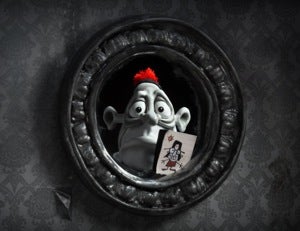 |
| Figure 1: Theatrical Poster (Luker, 2014) |
- Director: Adam Elliot
- Native Title: Mary and Max
- Primary Language: English
- Format: Colour
- Year of Release: 2009
- Budget: est. AU$8,000,000
- Film Length: 90 minutes
- Production Company: Melodrama Pictures
An independent stop-motion animation released in 2009, Mary and Max is an Austrailian story about two long term pen-pals that looks heavily into long-distance friendship, loneliness, and mental conditions, primarily Asperger's Syndrome but also touches on others.
Mary and Max mixes drama and dark humor to create a story about friendship between two lonely people on opposite sides of the world and a strong example that animation is not necessarily a medium suitable for children though the use of a mature subject matter and a peculiar, sometimes rather disturbing sense of humour.
The film tells the story of Mary Daisy Dinkle, a sweet, lonely innocent child of the Melbourne suburbs and Max Jerry Horowitz, an equally lonely Jewish man living in New York City. While separated by the Pacific Ocean and most of the American continent, the two become firm pen-pals on a journey to learn friendship from each other.
 |
| Figure 2: Max's world is very dull. So when Mary sends him gifts the colour difference is suitably alien. (Pond, 2019) |
One of the first things that stood out with Mary and Max was its animation style. The film's visual style is highly reminiscent of the works of Aardman (
Wallace and Gromit, Creature Comforts). The film mixes between two distinct palettes; sepia for Mary's world and grey monochrome for Max's
"All of this is rendered in almost completely monochromatic claymation – only occasional colours stand out, such as the red pompom Mary sends to Max at one point." (Pulver, 2010). This is more than separating the tone to show the locations: Mary frequently sends care packages to Max, and those objects retain their colour in his world. When she sends him a bright red pom-pom. In a way, this works to the advantage of the story ad to explain how Max lives and understands the world.
We learn halfay though the film that Max suffers from Asperger's Syndrome, a neurological condition that can emerge as a developmental disorder.
"Clues and contexts are explored (his behaviours and even the use of black and white footage used during scenes with Max; underlining his perspective of life)" (Newbutt). With Asperger's Syndrome, Max prefers a quiet, plain and organised life, and the use of a monochrome colour palette for Max's world rather beautifully highlights when strange or alien things to him emerge in his life, such as the aforementioned pom-pom, or more crucially the bright red lipstick worn by an attendee of "Over-eaters Anonymous" who happens to like him in a romantic sense - something Max does not quite understand.
 |
| Figure 3: Max demonstrating his ability to solve complex tasks, much to the delight of his observers. (Newbutt 2014) |
But it is not just in colour;
"The way that the animation (and type of animation; Claymation) deals with and picks these themes up is expressive and at times emotive. The use of exaggeration and other animation principles is well thought-out and utilized.." (Newbutt, 2014). For someone like Max, the exaggeration could be a way to portray how the world of a normal person seems to him, again a reflection on how the mind of someone with the condition may prefer quieter or more subtle experiences, and serves to highlight how chaotic New York City must seem to a man like Max.
 |
| Figure 4: Where babies come from according to Max's mother. A milder example of the kind of comedy that fills the film. (Azevedo, 2013)) |
Somewhat fitting for the rather tense themes, the sense of humour the film has is definitely something to be acquired, as they can straddle into dark places but is occasionalyl sprinkeld with endearing moments. "
The subject matter and tone of the film is often dark, sad and upsetting but Elliot skilfully balances such moments with dark humour and carefully timed endearing moments." (Caldwell, 2009)
The story and animation skilfully weave both sweetness and dark comedy, and there are a number of cases where a viewer might end up simultaneously smiling at something lovely, reeling at the dark content that accompanies it but still laughing at the absurdity of it all. Three of the more notable examples include Mary's efforts to produce tears for Max by way of imagining Ethel getting run over by a lawnmower, a montage of ways in which Max's goldfish die - such as flying into a toaster - while under the care of the (almost) blind old lady who lives next door to him (who replaces each one she seems to kill), and Max's old imaginary friend Mr. Ravioli "leaving" him by rather cheerily saying bye jumping out of his apartment window to cause a car crash below.
Despite the sometimes childish comedy, exaggerated animation and endearing story, Mary and Max is a very mature tale, a story for adults that enlightens on the effects of social isolation, the cruelty of the world and the effects of an oft-misunderstood condition. For this, it is a very worthwhile watch, and once you look past the charming animations, you are met with something that can easily be enjoyed by adults. Making this a fine example of how animation can be immensely entertaining and endearing for adults.
References
Image References



























































